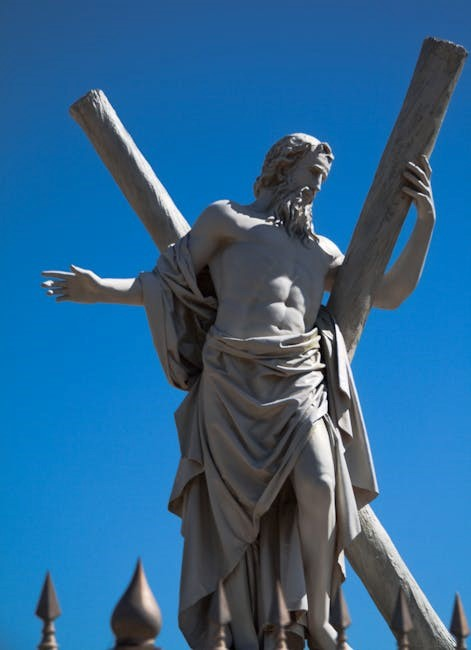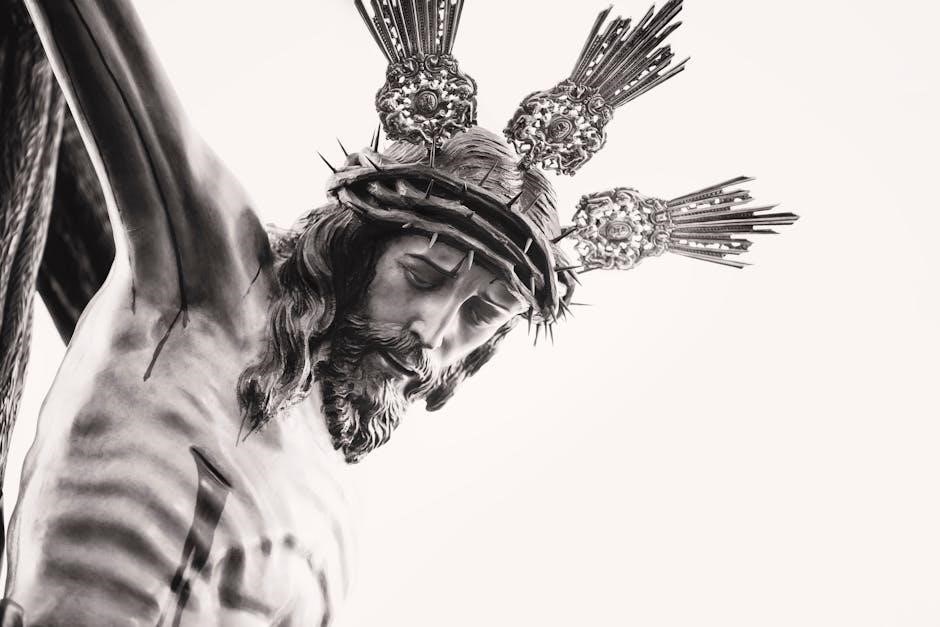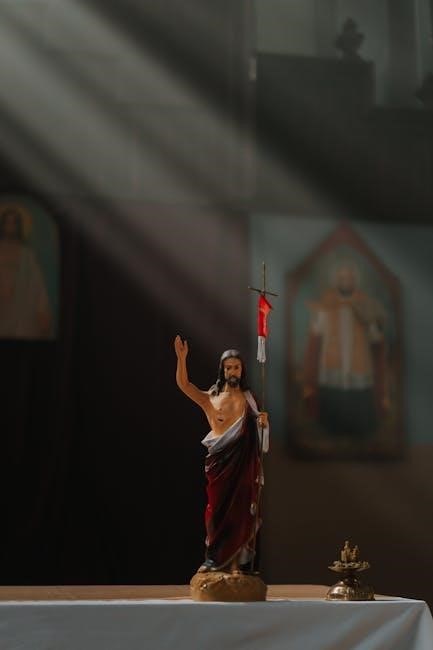Handel’s Messiah, composed in 1741, is a renowned oratorio with a libretto by Charles Jennens, first performed in Dublin in 1742. Its majestic choruses and arias have made it a cornerstone of classical music, celebrated for its spiritual depth and emotional resonance, remaining a holiday tradition worldwide.
Composition History
Composed in 24 days between August and September 1741, Handel’s Messiah is a masterpiece of Baroque music, with a libretto by Charles Jennens, premiering in Dublin in 1742.
2.1 Composition Timeline
Handel began composing Messiah on August 22, 1741, completing the draft by September 14, 1741. This intense period of creativity resulted in a work of profound spiritual significance, reflecting Handel’s deep connection to the libretto compiled by Charles Jennens. The composition process was exceptionally swift, even for Handel, who was known for his efficiency. Despite the rapid creation, Messiah showcases meticulous craftsmanship, blending intricate orchestration with powerful choral and solo movements. The work was finalized just in time for its premiere in Dublin, where it was first performed on April 13, 1742. This timeline underscores Handel’s artistic genius and his ability to produce a masterpiece under considerable time constraints.
2.2 Historical Context
Handel’s Messiah was composed in 1741 during a period of significant cultural and religious transformation in Europe. The work reflects the spiritual and artistic values of the time, drawing on biblical texts to convey a message of redemption and divine glory. Premiering in Dublin in 1742, Messiah resonated deeply with its audience, bridging the gap between sacred and secular music. Its creation coincided with a growing interest in oratorios, which were gaining popularity as a means of storytelling through music. The historical context also highlights the influence of the Church and the role of music in worship, making Messiah a landmark composition that continues to inspire audiences today. Its enduring appeal lies in its ability to transcend time, connecting generations through its universal themes.

First Performance in Dublin
Handel’s Messiah premiered on April 13, 1742, in Dublin’s New Music Hall, conducted by the composer himself. The performance was a charity event, raising funds for local hospitals and debtors’ prisons. Despite initial concerns about public reception, the oratorio was met with enthusiasm, drawing a large and diverse audience. The success of this debut solidified Messiah’s place in musical history, marking the beginning of its enduring legacy. The Dublin premiere not only showcased Handel’s genius but also demonstrated the power of music to unite people across social boundaries, leaving an indelible mark on the cultural landscape.
Structure of the Oratorio
Handel’s Messiah is divided into three parts, exploring prophecy, passion, resurrection, and redemption. It features recitatives, arias, choruses, and grand orchestration, creating a dramatic narrative flow.
4.1 Part I: Prophecy and Birth
Part I of Handel’s Messiah introduces the prophecy and birth of Jesus Christ, drawing from Old Testament texts. It begins with an overture, followed by a tenor recitative, “Comfort ye, comfort ye my people,” setting a tone of hope. The section progresses with arias and choruses, including “Every valley shall be exalted” and “And the glory of the Lord.” These pieces emphasize the Messiah’s coming and divine glory. The narrative culminates in the announcement of Jesus’ birth, with the chorus “For unto us a child is born,” showcasing Handel’s masterful use of choral and orchestral elements to convey spiritual joy and anticipation.
4.2 Part II: Passion and Resurrection
Part II of Handel’s Messiah depicts the Passion and Resurrection of Jesus Christ, exploring themes of sacrifice, redemption, and triumph. The section begins with a somber tone, reflecting on Christ’s suffering, as seen in the alto aria “He was despised and rejected of men.” The narrative progresses to the Crucifixion, with the chorus “Surely, He hath borne our griefs” emphasizing the Messiah’s burden of humanity’s sins. The dramatic turning point arrives with the Resurrection, celebrated in the iconic “He is risen” and the triumphant “Hallelujah Chorus,” which underscores divine victory over death. This part masterfully balances sorrow and jubilation, showcasing Handel’s ability to convey profound theological themes through music, making it a cornerstone of the oratorio’s enduring legacy.
4.3 Part III: Redemption and Glorification
Part III of Handel’s Messiah focuses on the themes of redemption and glorification, culminating in the triumph of the Messiah. The section opens with the beautiful soprano aria “I know that my Redeemer liveth,” expressing unwavering faith in salvation. The bass aria “The trumpet shall sound” heralds the resurrection of the dead, while the chorus “Worthy is the Lamb that was slain” glorifies the Messiah, building to the majestic “Amen Chorus.” This final part emphasizes the fulfillment of divine prophecy and the ultimate victory over sin and death, reflecting the oratorio’s central message of hope and redemption. The grandeur of the music and text in this section underscores its profound spiritual significance, leaving a lasting impression on listeners and solidifying its place as a masterpiece of sacred music.
Libretto and Textual Sources
Charles Jennens compiled the libretto for Messiah, drawing from the King James Bible and the Book of Common Prayer. His text weaves together prophetic and redemptive themes, creating a narrative that spans the prophecy of the Messiah, His birth, passion, resurrection, and glorification. Jennens’ work provided Handel with a rich, cohesive foundation for his masterpiece, ensuring the oratorio’s theological depth and emotional impact. The libretto’s structure and textual sources remain central to the work’s enduring significance in classical and sacred music traditions.
5.1 Charles Jennens’ Contribution
Charles Jennens, an English landowner and literary figure, played a pivotal role in the creation of Handel’s Messiah by meticulously compiling the libretto. Drawing from the King James Bible and the Book of Common Prayer, Jennens crafted a narrative that seamlessly integrated Old Testament prophecies with New Testament fulfillment, focusing on the life, death, and resurrection of Jesus Christ. His text, structured into three parts, provided Handel with a theological and emotional framework that elevated the oratorio to a masterpiece of sacred music. Jennens’ meticulous selection of scriptural passages ensured coherence and theological depth, making his contribution indispensable to the work’s enduring legacy. His collaboration with Handel exemplifies the fusion of literary and musical genius in creating a timeless classic.
Sheet Music and Score Availability
Handel’s Messiah sheet music and full score are widely available in PDF format from sources like Musopen.org and the Internet Archive, offering free access for download and practice.
6.1 Full Score and Parts
The full score and individual parts of Handel’s Messiah are readily available in PDF format from reputable sources like Musopen.org and the Internet Archive. These resources provide high-quality, downloadable versions of the complete oratorio, including instrumental parts for orchestra and vocal scores for soloists and chorus. The scores are meticulously transcribed from Handel’s original manuscripts, ensuring authenticity and fidelity to the composer’s intent. Musopen.org, in particular, offers copyright-free access, making it an invaluable resource for musicians, conductors, and music enthusiasts. Additionally, the Internet Archive hosts vintage editions and rare publications, catering to scholars and those interested in historical performances. These digital archives ensure that Handel’s masterpiece remains accessible and performable for future generations.
Orchestration and Vocal Scoring
Handel’s Messiah features a rich orchestration and vocal scoring, characteristic of Baroque grandeur. The oratorio is scored for a symphony orchestra, including strings, woodwinds, brass, and timpani, alongside a harpsichord for continuo. The vocal forces include a four-part chorus (soprano, alto, tenor, bass) and solo voices, typically soprano, alto, tenor, and bass. Handel’s masterful use of instrumentation enhances the dramatic and emotional impact of the text, with intricate counterpoint and harmonies. The interplay between vocal and instrumental elements creates a dynamic and layered sound, exemplifying the composer’s skill in balancing complexity with clarity. This orchestration has been meticulously preserved in modern PDF scores, allowing contemporary performers to faithfully recreate Handel’s vision.
Hallelujah Chorus
The Hallelujah Chorus is the iconic climax of Handel’s Messiah, concluding Part II. This majestic chorus, written in the key of D major, showcases the full force of the orchestra and chorus, celebrating the resurrection and glorification of the Messiah. Its grandeur and emotional intensity have made it one of the most recognizable pieces in classical music. The chorus features intricate harmonies and a triumphant orchestral accompaniment, with the famous “Hallelujah” refrain repeated throughout. Often performed as a standalone piece, it has become a cultural phenomenon, with audiences traditionally rising to their feet during its performance. Handel’s masterful composition captures the joy and awe of the Messiah’s triumph, ensuring its enduring popularity in both sacred and secular contexts.

Historical Impact and Legacy
Handel’s Messiah has left an indelible mark on classical music and culture. Composed in just 24 days in 1741, it premiered in Dublin in 1742 and quickly gained acclaim. Its innovative structure and powerful emotional depth revolutionized the oratorio genre. Over centuries, Messiah has remained a staple of choral repertoire, performed annually worldwide, particularly during the holiday season. Its influence extends beyond classical music, with the Hallelujah Chorus becoming a cultural touchstone. Messiah’s enduring appeal lies in its universal themes of redemption and joy, resonating with diverse audiences. Its legacy is cemented through countless performances, adaptations, and its role in shaping Western musical traditions. Messiah continues to inspire new generations, ensuring its place as a timeless masterpiece of sacred music.

Cultural Significance
Handel’s Messiah holds profound cultural significance, transcending its role as a musical masterpiece to become a symbol of spiritual and communal celebration. Its iconic choruses, particularly the Hallelujah Chorus, have become deeply ingrained in Western cultural consciousness, often featured in films, television, and public events. The oratorio’s themes of redemption and hope resonate universally, making it a beloved tradition during holidays and religious observances. Messiah sing-alongs and performances have fostered community bonding, with many audiences participating annually. Its influence extends beyond classical music, inspiring adaptations in various genres and cementing its status as a cultural touchstone. Messiah’s enduring popularity reflects its ability to unite people across generations and backgrounds, solidifying its place as a timeless cultural treasure.

Performance Traditions
Handel’s Messiah is traditionally performed with a large chorus and orchestra, often featuring audience participation. Many communities hold annual sing-alongs, fostering a deep connection to the music.
11.1 Modern Performance Practices
Modern performances of Handel’s Messiah often blend historical accuracy with contemporary interpretations. Many ensembles use period instruments to replicate the original sound, while others incorporate diverse vocal styles. The availability of the score in PDF format has democratized access, allowing amateur and professional groups alike to perform the work. Conductors frequently emphasize clarity and balance, particularly in complex choral passages, while soloists bring fresh emotional depth to iconic arias. Additionally, some modern adaptations infuse the oratorio with cultural influences, such as gospel or world music elements, broadening its appeal. The rise of digital platforms has also made it easier for audiences to engage with performances globally, ensuring Messiah’s enduring relevance in today’s musical landscape.
Downloading the Messiah PDF
Handel’s Messiah is widely available as a free PDF download from sources like Musopen.org, offering the full score for study or performance, ensuring accessibility for all musicians.
12.1 Free Resources from Musopen.org
Musopen.org provides complimentary access to Handel’s Messiah in PDF and MP3 formats, enabling musicians and enthusiasts to download the full score and parts without copyright restrictions. This platform, dedicated to preserving classical music, offers high-quality resources, making Messiah accessible for both personal enjoyment and professional use. The availability of sheet music for various instruments, including piano, guitar, and flute, ensures versatility for performers. Additionally, Musopen.org’s commitment to free access supports educational initiatives and community performances, fostering the appreciation and dissemination of Handel’s masterpiece globally.

Modern Performances
Musopen.org offers a comprehensive collection of Handel’s Messiah resources, including full scores and parts in PDF format, free for download. This platform provides high-quality sheet music, enabling musicians to access the complete oratorio without copyright restrictions. The availability of individual instrument parts, such as piano, guitar, and flute arrangements, caters to diverse performance needs. Musopen.org also offers MP3 recordings, allowing listeners to study or enjoy the masterpiece digitally. These resources are particularly valuable for educational purposes, community performances, and personal practice. By making Messiah accessible, Musopen.org supports the preservation and dissemination of classical music, ensuring Handel’s timeless work remains widely appreciated and performed.

The Messiah as a Holiday Tradition
Handel’s Messiah has become a beloved holiday tradition, particularly during Christmas and Easter. Its spiritual themes and soaring choruses resonate deeply, making it a staple in churches and concert halls worldwide. Many communities perform the oratorio annually, often involving local choirs and orchestras. The iconic “Hallelujah Chorus” is a highlight, frequently performed as a standalone piece during festive celebrations. PDF scores of Messiah are widely available, enabling groups of all sizes to participate. This tradition not only honors the work’s historical roots but also ensures its continued relevance and accessibility, fostering a sense of unity and shared cultural heritage during the holiday season.
Personal Stories of Messiah’s Influence
Handel’s Messiah has profoundly impacted individuals across generations. For instance, a choir conductor in New Zealand, named Haniteli, draws inspiration from the oratorio, connecting his Tongan name (meaning “Handel”) to its legacy. Similarly, a couple shared how hearing Messiah in a church deepened their spiritual journey, highlighting its emotional and theological resonance. Such personal stories illustrate how the work transcends mere music, becoming a source of inspiration and comfort. These experiences underscore the enduring relevance of Messiah in people’s lives, bridging cultural and generational gaps through its universal themes of hope and redemption.
Handel’s Messiah remains a timeless masterpiece, celebrated for its spiritual depth and musical brilliance. Composed in just 24 days, it has become a cornerstone of classical music, resonating with audiences for centuries. Its availability as a free PDF ensures accessibility for performers and enthusiasts worldwide. From its debut in Dublin to modern performances, Messiah continues to inspire, offering a profound exploration of redemption and hope. Its cultural and emotional impact endures, making it a cherished tradition during the holidays and beyond. This oratorio not only reflects Handel’s genius but also the universal themes that unite us all.
